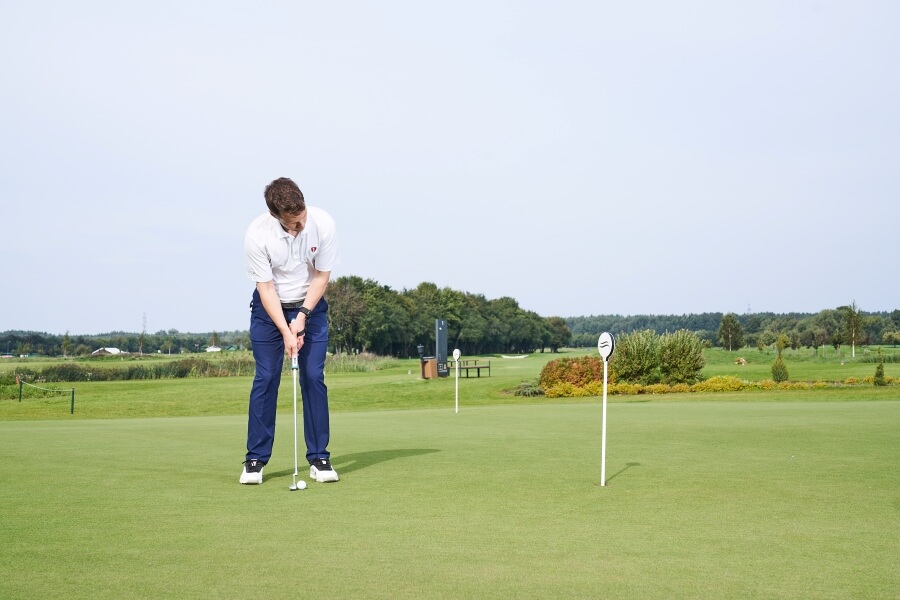How to Prepare for a Golf Tournament: Complete 8-Week Practice Plan + Essential Tips
Golf tournaments bring out the nerves, the adrenaline, and hopefully some of your best golf. But playing well under pressure doesn’t happen by accident; it’s the result of structured preparation.
This guide gives you a complete 8-week tournament prep plan along with practical advice on course strategy, equipment, nutrition, and mental preparation.
Follow it step by step, and you’ll walk to the first tee confident, calm, and ready.
Golf Tournament Preparation (Key Takeaways)
The golf tournament practice plan takes a littel bit to read through and plan, if you want a basic overview of the important points, here is what you should know:
- A structured 8-week plan helps you prepare physically, mentally, and strategically.
- Balance practice with fitness, recovery, and course management, not just swing mechanics.
- HackMotion is your “coach on the wrist,” helping you monitor wrist positions and clubface control under pressure.
- Tournament success comes from consistency in small details: hydration, sleep, equipment prep, and sticking to routines.
- The players who can adjust on the fly are usually the ones who rise to the top.
Structured preparation works best with guided feedback. Consider booking golf lessons near you to fine-tune your game before tournament day.
Contents
- 8-Week Golf Tournament Practice Plan
- General Tips: Night Before & Morning Of
- FAQ: Preparing for a Golf Tournament
- How early should I arrive before a golf tournament?
- What should I eat before a golf tournament?
- What’s the most important thing to practice before a tournament?
- Should I play the day before a tournament?
- How do I handle nerves in a golf tournament?
- What equipment should I double-check before a tournament?
- Final Thoughts
8-Week Golf Tournament Practice Plan
Week 1–2: Assessment of Your Golf Game
The first step is to figure out exactly where your game stands. Play a few practice rounds and note the areas where you’re struggling.
Track scrambling percentage, record where your misses go (short, long, left, right), and check your club distances. If you have access to a launch monitor, record swing speed numbers and carry distances.
Practice:
- Play at least two practice rounds focusing on conservative golf, no hero shots, no chasing pins.
- Spend 30 minutes at least four times during these two weeks working on getting up and down (chipping, pitching, bunker shots, and putting).
- Begin a swing speed training program like SuperSpeed or Rypstick to add speed before the event.
- Wear HackMotion during these sessions to check clubface angles and wrist mechanics under speed training.
Physical Conditioning (Weeks 1–2):
| Focus | Exercises | Frequency |
|---|---|---|
| Strength | Squats (3×10), Deadlifts (3×8), Planks (3×1 min) | 3x per week |
| Flexibility | Shoulder, Hip Flexor, Hamstring stretches (3×30 sec each) | Daily |
Studying the tournament course at this stage also pays off, know where the trouble is, what clubs fit best, and how the format will shape your decisions.
Week 3–4: Intensified Practice and Adjustments
Now it’s time to put yourself under pressure. These two weeks are about making practice feel like a tournament.
With the right strategy you’ll help yourself perform under pressure on the golf course.
Practice:
- Play at least two rounds under pressure, match play with a friend, play for small stakes, or add conditions that make each shot matter.
- Before each round, use a yardage book or GPS to create a hole-by-hole game plan. Analyze afterward to see if you stuck to it.
- Add in specific putting and chipping drills: Ladder Drill, Clock Drill, and Up & Down practice.
- Continue with swing speed training.
- Use HackMotion to monitor wrist positions in short game practice—look for consistency in putting and flexion in the lead wrist while chipping.
Physical Conditioning (Weeks 3–4):
| Focus | Exercises | Frequency |
|---|---|---|
| Flexibility | Cat-Cow, Torso Twists, Hip Flexor stretches | Daily |
| Plyometrics | Box Jumps (3×10), Medicine Ball Throws (3×15) | 2x per week |
| Cardio | Light running or cycling (30 min) | 2–3x per week |
Practice recovery shots as well, low punch-outs, flop shots, and even one-handed swings from tight spots.
These situations always come up in tournaments. And continue refining your pre-shot routine so it becomes second nature.
Week 5–6: Fine-Tuning and Tournament Simulation
At this stage, you’re more than halfway there. The focus now is on simulating tournament conditions as closely as possible.
This is especially important for those who have very little tournament experience.
Practice:
- Play several full practice rounds under strict rules, count everything, no mulligans. If possible, play with someone slightly better to increase the challenge.
- Pressure putting challenges: make 10 in a row from 5 feet, then back up to 6 feet, and so on.
- Practice short game and approach shots from tough lies: slopes, thick rough, tight fairway grass.
- Work on visualization, see your shots before you hit them, and stick to your pre-shot routine every time.
- Wear HackMotion when chipping and pitching to check that lead wrist positions stay consistent.
Physical Conditioning (Weeks 5–6):
| Focus | Exercises | Frequency |
|---|---|---|
| Flexibility | Hamstring & Shoulder stretches (3×30 sec) | Morning & Evening |
| Recovery | Foam Rolling: Quads, Calves, Back (2 min each) | After workouts |
| Cardio | Maintain light cardio | 2x per week |
This is also the time to check your equipment, clean grooves, fresh grips if needed, and make sure everything in your bag is tournament-ready.
Use a launch monitor to check for any distance changes from your swing speed training.
Week 7–8: Tapering and Final Prep
You’re close to tournament time. Now it’s about tapering down, no big swing changes, no crazy workouts, it’s best to leave your equipment the same as well. It’s time to just sharpen.
Practice:
- Play a few rounds focusing on strategy over score. Stick to your game plan.
- Review notes from earlier weeks and make final adjustments.
- Shift swing speed training to balance, rhythm, and tempo.
- Keep chipping, pitching, and putting sharp without changing technique.
- Wear HackMotion to confirm your wrist positions are consistent and not slipping under nerves.
Physical Conditioning (Weeks 7–8):
| Focus | Exercises | Frequency |
|---|---|---|
| Flexibility | Light stretching (hips, back, shoulders) | Daily |
| Recovery | Sleep, hydration, foam rolling | Daily |
| Maintenance | Walking, light bodyweight moves | 3x per week |
Make sure sleep, nutrition, and hydration are dialed in. Pack your bag early, mark your balls, and if the option exists, consider hiring a local caddie for insider knowledge of the course.
General Tips: Night Before & Morning Of
When the big day arrives, you’ll need some of these basic tips to ensure you perform to the best of your abilities.
It’s important to understand that you will likely be nervous but that nervousness can be used to help you play better. Embrace it.
- Eat smart: Keep meals light and balanced (protein + healthy fats). Avoid heavy food that slows you down.
- Stay hydrated: Aim for at least one liter of water every nine holes. Avoid alcohol and too much coffee.
- Arrive early: Give yourself time to stretch, practice, and avoid rushing.
- Warm up: 20–30 minutes of dynamic stretching, light range work, chipping, and putting.
- Stick to your pre-shot routine: It’s your anchor when nerves hit.
FAQ: Preparing for a Golf Tournament
Tournaments generate nervousness for most golfers, and those nerves bring up lots of questions.
Here are some things to know about preparing for a golf tournament.
How early should I arrive before a golf tournament?
Aim to arrive at least an hour before your tee time. This gives you enough time to check in, stretch, warm up with a few chips and putts, and avoid feeling rushed.
What should I eat before a golf tournament?
Stick to light, balanced meals with protein and healthy fats. Avoid heavy or greasy foods that could slow you down. Good options are eggs, oatmeal with fruit, or a banana with nut butter.
What’s the most important thing to practice before a tournament?
Your short game. Putting and chipping can save you when nerves make ball-striking inconsistent. Practicing your pre-shot routine also helps build consistency under pressure.
Should I play the day before a tournament?
Yes, but keep it light. Focus on short game, putting, and course familiarization. Avoid a long grind session or making swing changes the day before.
How do I handle nerves in a golf tournament?
Use your pre-shot routine as an anchor, focus on one shot at a time, and practice visualization. Nervous energy is normal, channel it into focus instead of fighting it.
What equipment should I double-check before a tournament?
Make sure your clubs are clean (no more than 14 in the bag), grips are in good shape, balls are marked, and rangefinders or GPS devices are charged. Pack snacks, extra gloves, and weather gear.
Final Thoughts
Tournament golf will always test your nerves, but the players who prepare best usually perform best.
With this 8-week plan, you’ll work on every part of your game, technical skills, short game, fitness, mental prep, and strategy.
Your round won’t always go according to plan, but preparation gives you the ability to adjust. Trust your practice, lean on your pre-shot routine, and let HackMotion act as your “coach on the wrist” to keep wrist mechanics sharp when it matters most.













